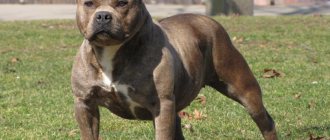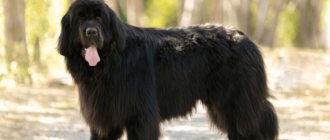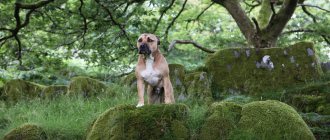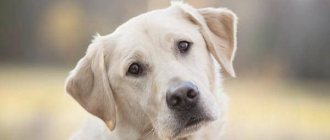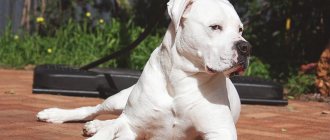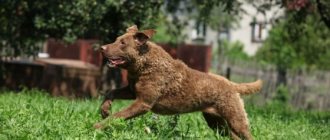The Labrador Retriever is a breed whose representatives always attract attention. They have an attractive and impressive appearance and a kind character. Let's take a closer look at who a Labrador Retriever is: description and characteristics of the breed, reviews from owners. These dogs have a harmonious combination of temperament and appearance. They are good companions and able to work.
Labradors are very useful for people. At the same time, it is difficult to call them guards and achieve aggressive behavior. The pet can notify of danger by loud barking. He is cheerful, which can be seen in his eyes. The dog is sure that the world is beautiful and no one will harm him.
Brief characteristics of the breed Amenable to training:
Gets along with animals:
Dirt in the apartment:
Puppy price:
Immunity and health:
Attachment to the owner:
History of the Labrador Retriever
The origin of the breed is still completely unknown. There is information that the first representatives came to England from Canada, the island of Newfoundland. The dogs first got their name from the island.
There are several theories about the appearance of the Labrador Retriever. One of them indicates origin from the Newfoundland breed. Breeder Dr. Woods believes that the breed originated on the island and involved Viking and Basque dogs. This kind of life affected the dogs’ habits. They feel equally at home on land and in water.
Fishermen from Newfoundland needed a helper - small in size so that he could get in and out of the boat himself. Water-repellent coat, high work capacity and a strong search instinct - these qualities are also important for fishermen.
During this period, two types of breeds developed - small and large representatives. Large dogs were used as draft force. But from the beginning of the 19th century they were sold to aristocrats in England because large dogs with long coats became fashionable. The name of the island stuck with them.
The small representatives were distinguished by waterproof and short hair, energy and agility. They felt great in the water and had a unique sense of smell. The dogs had names such as Lesser Newfoundland, Lesser St. John's and even Labrador. Large Newfoundlands are now very common, and from the small breeds Labradors evolved.
English athletes noticed the dogs' flexibility and swimming abilities. When pheasant hunting became fashionable, retrievers were used instead of setters and pointing dogs. At this time, the purity of the breed was not very important, so owners got puppies from parents with long and short coats.
Since 1830, small dogs began to be transported to England to develop a separate breed. Breeders began to follow a number of rules in order to preserve the natural characteristics of the dog. But they often experimented with breeding Labradors with other retrievers.
At the beginning of the century, Labradors appeared at exhibitions in England. At this time, retrievers were considered to be representatives with short and long coats, dark brown dogs and Norfolk dogs, which are no longer present. Later each species became a separate breed. Since 1903, Labrador Retrievers have been officially registered with the Kennel Club. For twenty years, large nurseries improved the breed and as a result modern representatives were formed.
Height and color
Labrador growth standards are 56-57 cm for a male, 54-56 cm for a female. American standards have minor differences: 57-62 cm for a male, 55-59 cm for a female.
The most common color is black. Actually, it all started with black Labradors. Classic, this color looks great, shimmering like black satin. The color may include a small light spot on the chest.
One day, from two black parents, a puppy was born whose color was called field. Now it has several shades: from cream to reddish. In terms of physical and mental qualities, such dogs are not inferior to black ones.
Recommended reading:
Husky: description of the breed, character traits, content
Another color is chocolate, and it appeared earlier than the field color. In this case, spots of a different color should not be on the coat. The color became popular after Clinton brought a brown Labrador into his family.
Breed characteristics
The Labrador is a carefree, cheerful and obedient dog. Differs in the following features:
- Balance and stable psyche.
- Versatility. The pet can act as a guide, companion, hunting dog, and even look after children.
- Strong build, the animal feels good in water.
- Webbing between the toes, due to which the Labrador does not get tired from swimming and moves quickly.
- A specific body structure that helps make long jumps.
- The tail is wide at the base, similar to the tail of an otter. In water it works like a rudder.
- When a pet wags its tail in the apartment, small things get lost.
- The coat helps to swim for a long time. It has many layers, a thin layer of fat.
- Thanks to the soft mouth, objects are not squeezed in the mouth.
- The dog is obedient, easily makes contact with the owner and trainer during training.
- Good health, but there are diseases of the joints, knees and hips. Sometimes there is an eye defect of a genetic nature.
Representatives of the breed are active, hardworking and love to play. Dogs are considered sprinters. On land they reach speeds of up to 20 km/h, in water – up to 5 km/h (more than ducks). The record jump is more than 8 m. Owners are often interested in the question, how long do Labradors live at home? Average life expectancy is 10-14 years. The first heat can begin at 8-12 months.
Breed standard
Representatives of the breed have developed muscles and a proportional physique. Their main characteristics:
- Wide head. In babies aged 3-4 months, it looks much larger than the body.
- The body is strong and long, wide chest, strong neck. Muscular and short lower back.
- Hanging ears are located slightly behind. The eyes are almond-shaped and widely set.
- The limbs are neat, round, webbed.
- The tail is similar to that of an otter. Thick at the base, tapering strongly at the end, oriented horizontally.
- The coat is hard, short and dense, the undercoat is well developed and has water-repellent qualities. Labradors inherited it from ancestors who lived in cold climates.
Wool generally has the following colors:
- black;
- pale yellow;
- brown (chocolate).
There are also additional acceptable colors:
- Golden.
- Cream.
- Fox ed.
There may be a small white spot on the chest. Let's look at the weight by month in the table.
| Age, months | Weight, kg |
| 1 | 3,4-3,8 |
| 2 | 7-8 |
| 3 | 12-14 |
| 4 | 17-19 |
| 5 | 21-22 |
| 6 | 24-26 |
| 7 | 26-28 |
| 8 | 28-30 |
| 9 | 29-32 |
| 10 | 30-36 |
| Further | 30-40 |
Character of dogs
Labradors are very smart, kind and energetic. They sense the owner's mood well. If the owner is not in a good mood or wants to relax alone, the pets will not pester. But it is important to direct a stormy temperament in the right direction, without punishment.
Dog owners especially emphasize the following character traits of the breed:
- kindness and positive attitude;
- loyalty and reliability;
- activity;
- intelligence;
- performance.
Labrador is considered a good companion. He is happy to serve the family and always be close to his owners. The pet vigorously shows joy by wagging its tail, which is why objects often fall off the shelves. At three years of age, dogs usually become calmer.
Animals love to be in the water, walk and run with the owner. They need constant attention. They do not show jealousy or aggression. People are attacked solely to play. Excellent students, they remember commands well. Training can take place at home.
The pet often barks, but not always for security purposes. Usually he's just happy to see everyone. Loves children, other dogs and even cats. Does not get along with birds, as the breed was bred to hunt pheasants. Instinct can awaken even in domestic dogs.
Before you think about keeping a Labrador in an apartment, you need to weigh the pros and cons. The pet sheds a lot, so cleaning can be difficult. It will take a lot of time for training, education and walking. But being in the fresh air is beneficial for the person himself. The animal's good qualities, such as loyalty, kindness and optimism, help to forget about shortcomings.
Health and life expectancy
With proper care, Labradors live 10-14 years.
Health problems and prevention:
- Many diseases in Labradors are hereditary. You should ask breeders about the health status of the puppy's parents.
- Dysplasia is a defect in the hip joint. To avoid this defect, you need to closely monitor the puppy. Until the age of 6 months, he should not be exposed to physical exertion and should not move up the stairs independently.
- Diabetes and obesity. Everything here is actually simple - proper nutrition and balanced exercise. To check whether you have overfed your Labrador or not, feel the ribs. They should not be visible, but should be felt.
- Allergy. The main cause of attacks is food, chicken being the most allergic. For prevention purposes, you can use a 1-3 week course of enterosgel. You need to make sure that the Labrador eats, and do not allow your friends to treat him with anything. Self-medication is not suitable in this situation. You need to go to the vet immediately.
It is necessary to be vaccinated against canine distemper, infectious hepatitis, rabies, parvovirus enteritis, parainfluenza, leptospirosis.
How to care at home?
Puppies and young pets are very active. They want to taste everything and get into everything. The tail lives on its own, knocking down objects around it. The Labrador's behavior is fun, but there is a risk of injury, poisoning, electric shock and intestinal obstruction. Therefore, you should keep your apartment perfectly clean. To prevent your pet from damaging the furniture, you need to distract him with games.
If you walk your dog often, by the time it is two years old, it will become calmer. But while growing up, you don’t need to count on a quiet life together. The breed does not have any exceptional features of keeping it in an apartment - its own place (it is better to choose an orthopedic mattress), a stand or non-slip dishes, evening exercise (so as not to disturb the owners’ sleep). Water treatments as necessary to prevent your pet from smelling like a dog.
Pets' fur is not very long, but it sheds a lot. Especially with insufficient walking in winter. If the baby gets used to the vacuum cleaner, the hairs can be collected with a brush or pipe. Many owners say that their puppies love this procedure.
The following tools will help in caring for the coat:
- Metal scraper with loop. If the undercoat is not too thick, it is used for the limbs and lower part of the body. You should not press intensely. Otherwise, the dog may be scratched and dermatitis and scratching will appear.
- Wide stripping. Used to prepare the dog for trimming. The thick undercoat is combed out well.
- Rubber scraper. Excellent collection of awns. A standard mitten with fingers will not bring results.
A furminator can cope with shedding, but using it before shows is dangerous, as it cuts off the spine. But if the breeder shows how to use it, it will fit the body.
Babies are brushed more so that they get used to it. Therefore, a massage brush with rounded teeth and a single-row brush will suffice. Add a gloss to the wool using a comb with boar bristles. If the shedding of an adult dog is not very strong, you can use the listed tools or purchase a slicker.
The coat should be combed dry and clean. Water procedures reduce the shedding time, and nutritional supplements lengthen it and harm the liver.
In hot weather, brown and black colors “rust”, so exhibition representatives should not be exposed to direct sunlight for a long time. A haircut will not help against the heat; the body will only heat up faster. It won’t save you from shedding either, since short hairs are more difficult to remove.
Nails are trimmed using special clippers. The cut is made below the living part of the claw. If your eyes are running, you should immediately contact a veterinarian.
According to reviews from owners, walking such a pet has the following features:
- Increased attention to passers-by, desire to play with them.
- Eating pieces of food on the asphalt, small gravel, leaves, which can cause diarrhea and vomiting.
- Frequent desire to run away. The pet does not hear the owner when he has found something interesting. Representatives of the breed often get lost, so it is necessary to attach a tag with a phone number and address to the collar.
- Excessive interest in all animals. If the dog you meet is friendly, the Labrador will want to tag along. You can run away from an aggressive dog and get lost.
Until your pet's training becomes perfect, you need to use a leash. Experienced owners recommend a standard fastening with three to five rings along the length.
Tape measures are not suitable for young pets. They get used to pulling without feeling jerks. There is no need for a noose or a strict collar unless we are talking about uncontrollable aggressors. Then they can be used temporarily. Harnesses should also not be chosen for walks.
Pets are not very clean and can get into deep puddles. In dirty weather, it is better to wear a raincoat. When training, you should use a blanket to avoid catching colds.
The cold is tolerated without problems. Labradors love snow more than heat. When walking for more than 15 minutes, you will need warm overalls. Especially when it comes to an elderly or unseasoned pet. Your pet can even live outside in winter if you provide it with cleanliness, warmth and sufficient attention. When keeping the animal outdoors, it is necessary to walk the animal and provide physical exercise.
Due to the fact that the fingers are pressed tightly against each other, debris accumulates between the pads. It gets stuck on thick fur. The dog, trying to get rid of it, wets its skin. As a result, there is a risk of infections and cracks. After walking, you will need to examine the limbs; in winter, you need to get rid of snowballs.
Before going out into the city, you should treat the pads with wax or Vaseline. This is necessary to protect the skin from reagents. When you get home, rinse with warm water.
Optimal living conditions
From the character description it is clear that these four-legged friends are characterized by a lively temperament and energy. The ideal place for them to live is a country house with an area where they can frolic for a long time. However, reviews from Labrador owners claim that she is happy in an apartment if the dog owner has time for regular walks in the park area, forays into nature and constant training. The main thing for a pet is not the number of square meters, but the duration of outdoor games and active entertainment. Unspent energy can lead not only to apathy and melancholy of the animal, but also to destructive behavior and unpleasant actions.
A pet may get used to whining or barking for no reason, and in an attempt to find a hobby, it will destroy or damage property in the house, for example, tearing shoes into pieces or chewing some furniture. Of course, in most cases this is typical only for dogs that are deprived of attention and spend the lion's share of their time in absolute solitude in a confined space.
Education and training
The pet is easy to train and train. It is necessary to start in a timely manner, otherwise the mature dog will develop unwanted habits. At three months, Labradors can already solve problems that others can only cope with at six to seven months. For training, you can contact specialists who use specially developed programs.
Your pet should not be left without activities. It is necessary that he brings slippers to the owner and catches toys. Dogs love to swim and dive. If you teach your pet the “Fetch” command and play with it, he will appreciate it.
Owners need to pay attention to their pet so that it gets used to communicating with people. It is important to patiently explain what not to do. It is necessary to educate without physical punishment and screaming.
You can read more about training and raising a Labrador in this article on our website.
What to feed a Labrador at home?
Dogs are not very picky eaters. They eat everything they find on the way or is on their plate. It is necessary to take a responsible approach to choosing a diet so that your Labrador does not become overweight and his health does not deteriorate.
You can give natural or prepared food. The latter are balanced and do not require cooking time. It is better to purchase food not lower than the premium segment in order to reduce visits to veterinarians.
Food is selected according to age criteria. If a dog is obese, it is put on a diet menu. There are options for nursing, weakened animals. Feeding occurs strictly according to the instructions on the package.
The following natural products are suitable for your dog:
- Boiled and raw meat, offal.
- Fish without bones, mostly from the sea.
- Cereals. Anything will do except barley and oatmeal. Porridge can be replaced with black bread crackers.
- Fermented milk products (cottage cheese, cheese), raw yolks with cereals and vegetables.
- Chopped zucchini, pumpkin, carrots, beets, cabbage with sour cream or butter.
In this case, vitamin complexes will be required. They are especially relevant in winter.
What food is best to feed a puppy?
First, the baby needs to be given the usual food. You should clarify this issue with the breeder. After a week, it is allowed to gradually introduce a new diet.
It is necessary to immediately teach the dog to eat in one place and at one time. A plate with pieces of uneaten food should be removed immediately. Water should always be available in the public domain. For small pets, the following nutritional plan is relevant:
- Up to 2 months – 6 times a day.
- Up to 4 months – 5 times.
- Up to six months – 4 times.
- 7 months – year – 3 times.
- Next - 2 times.
Maintenance and care
Place where Labrador will live:
- A place to sleep should be chosen based on two factors: temperature and tranquility. Away from radiators and windows, a secluded space is ideal for a Labrador. To provide additional safety from drafts, it is useful to arrange a bed that is 20 cm higher than the floor surface.
- If we talk about the place of the toilet, then the Labrador is constant in this matter. Where he went to the toilet for the first time, he will continue to go there after. Therefore, you only need to be on the safe side once and reward the puppy after the first time.
Recommended reading:
What is the name of the dog breed from the movie Hachiko?
Things to do:
- Everyone faces the problem of torn curtains and chewed furniture, you say. In fact, this is not true. To avoid this, you just need to give the puppy things specifically designed to be slowly destroyed. The main thing is that there should be no metal parts on toys. You should not play tug of war with your Labrador. This can ruin the ideal bite given by nature. Do not let your puppy crawl under sofas and chairs - it is bad for the spine.
- To reduce activity at home, you need to take your Labrador for walks more often. But the dog doesn’t need exhaustion either. You can go for a run with your four-legged friend or climb a mountain. But if you see that the Labrador is tired, then you see him home - do not make the animal feel tired. If your goal is training, then the load should be increased gradually.
Feeding:
- It is better to give preference to dog food. They have already calculated for you all the necessary elements and vitamins, and in what quantities your pet needs them. But you need to choose only high-quality food recommended by dog breeders and experts.
- For those who prefer natural food, we can recommend homemade cottage cheese, meat, sea fish (exclude fatty fish and pollock), crackers, buckwheat and rice cereals.
- Puppies need to be fed more often, and there is more fat, carbohydrates and meat per pound of weight. In the first two months, the puppy is fed 5 times, with the next two months the number of feedings per day decreases by one. An adult Labrador should be fed twice: morning and evening. Don't forget about water.
- The bowl should be located just above your elbows and made of stainless steel. This arrangement will maintain correct posture for your pet.
Essentials:
- Although Labrador Retrievers are rarely bathed, shampoo and a coat brush are necessary.
- Collar and muzzle. Labrador is a very active dog. She may not wish harm, but still attack the person she likes. So the Labrador needs these attributes, although their protective functions may not be useful.
Advantages and disadvantages of the breed
Pros of Labradors:
- good physical form;
- excellent health, endurance;
- adaptability to any climatic conditions;
- minimal care;
- ease of training, high ability to learn commands, agility;
- unique memory;
- innate fetching skills;
- devotion, lack of desire for dominance;
- adaptability to any rhythm of life of the owners.
Minuses:
- Excessive friendliness, lack of security abilities.
- High need for activity and training.
- Possibility of property damage due to boredom.
- Hyperactivity, which changes with proper upbringing.
- Slow growing up. Childhood lasts up to three years, which is why the dog sometimes does not obey.
- High love for water, the pet will dive into puddles.
- Lack of moderation in food. The dog eats everything that comes in its way.
- Desire to play with stray dogs and other animals.
- Uncontrollability in the absence of education. This is noticeable when walking, when the dog drags the owner in the right direction.
Bad habits can be eliminated with proper training. Then the negative qualities of the Labrador will not appear.
Memo to the owner of a Labrador puppy
The puppy is a fragile creature with weak ligaments and muscles. It is important not to take it unnecessarily or to do it correctly, that is, hold it tightly so as not to lose it. You need to lift the baby with both hands under the chest and seat at the same time, but not under the tummy.
The puppy's habitat should be spacious and soft, away from drafts. Small objects, wires and other hazards should be removed from the room.
All hygiene procedures described in the “Care” section of this article must be followed. Feeding is described in the “Nutrition” section.
What not to do:
- feed with sharp bones, as there is a risk of internal bleeding;
- pull objects out of the mouth for up to 8 months, so as not to spoil the bite;
- give sweets, baked goods, fatty and fried foods (this also applies to adult dogs);
- offer hot or cold (from the refrigerator) food;
- bathe often;
- stroke the ears;
- take your baby down the steps before 4 months;
- take a long walk after eating;
- swing or hit when punished;
- lead the puppy on a harness.
Diseases and pathologies to which dogs are susceptible
Labradors may suffer from the following diseases:
- Dysplasia of the hip or elbow joint. In this case, the hind or front legs fail.
- Excess weight.
- Panosteitis. A pathology that develops due to rapid growth. Young dogs often get sick.
- Osteochondrosis. The hock, knee and shoulder joints are usually affected.
- Cataracts, progressive retinal atrophy.
- Licking granuloma. Idiopathic licking causes ulcers on the paws. Usually observed in representatives of the fawn colored breed.
- Epilepsy. Rarely appears.
- Dandruff.
Labradors often have bald patches on their elbows. They appear due to an incorrect diet and hard floors in the apartment.
Origin
The history of the breed has several versions based on legends. It is believed that it originates on the island of Newfoundland (now this area belongs to Canada). One part of the scientific community accepts the version that initially Labradors were only black in color, therefore they were named because of the similarity of the shade with the labradorite stone. Other experts suggest that the breed was bred on the Labrador Peninsula.
In the 19th and 20th centuries, English aristocrats were of great interest in this breed. Feedback from Labrador owners of that time made it a fashionable hunting dog, distinguished by its special nobility. Influential people created nurseries in their domains, kept pedigree books, and organized demonstration competitions.
The fame of this extraordinary pet has spread throughout all countries of the world. Every day he wins the hearts of new dog breeders.
The cost of a puppy and how to choose one?
The price of a Labrador retriever is influenced by the following criteria:
- pedigree;
- quality of cultivation;
- appearance.
These add up to the cost - from 20 to 60 thousand rubles.
When purchasing, you should pay attention to the following nuances:
- Lack of aggressiveness and timidity.
- Friendliness.
- Thick build without excess weight.
- A good appetite.
- No fleas or damage to the skin.
Reviews
Activity, devotion, friendliness and good appetite - this is how Labrador owners describe their pets. Your reviews of the breed will most likely also note these qualities if you decide to take this dog into your family. By nature, she suits absolutely everyone and fits in well in families with children. Many reviews say that the pet, with its love of life and kindness, strengthened friendly relations in the family. Apparently, it is not for nothing that this breed is considered to be a symbol of family well-being and happiness.
Having reviewed all the opinions and incidents from the lives of pets described by the owners, you can only find positive things. This four-legged friend will win the heart of every dog owner.
What to name a Labrador?
It is easy to choose a nickname for representatives of this breed. The dog is big, but very kind. Therefore, both cute names (Baby) and representative names (Count) are suitable for her.
boy
Many owners name their animals after their favorite singers, actors, literary and mythological characters. Fans of The Three Musketeers can name the boy Athos, Porthos or Aramis. The name Locky is suitable for cunning pets. Often English nicknames are chosen for Labradors, such as Mike, Harry, Charlie, Bobby, Alex, Chris.
girl
Female Labradors are charming, loyal and devoted. The name Diana is suitable for the pet, in honor of the Roman goddess of the hunt. Aurora, Assol, Elsa, Stella are gentle nicknames that personify the character of dogs. Names named after flowers will sound harmonious - Jasmine, Rose, Astra.
Video: Labrador Retriever: description and characteristics of the breed
Where can it be useful?
This dog breed is very versatile. She can become either just a pet or used as a rescuer, guide, hunter or police officer. The breed was originally bred as a working dog, so it is characterized by strength and endurance.
Currently, these dogs are successfully used in rescue work. Reviews from Labrador owners in most cases indicate that their four-legged friend is a born swimmer. Not only is it a great swimmer, but it is also capable of working in icy waters thanks to its waterproof coat.
Quite often you can see a Labrador in the role of a police officer. You should know that this pet’s sense of smell is 25% more perfect and better than that of a German shepherd. Thanks to his balance and intelligence, he copes well with tasks. Moreover, his motivation is devotion and loyalty to people, and not innate anger, like some other dog breeds. For example, in the UK, a Labrador named Yogi was awarded the Knight's Gold Medal for the discovery of 490 cargoes containing drugs.
There are cases when these dogs helped patients with epilepsy, warning the owner about the next attack.
But it is unlikely that you will be able to use this pet as an evil guard. He is too friendly and completely non-aggressive to scare away strangers and protect the object.
